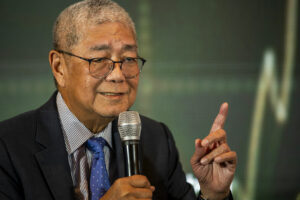THE WINDOW for the Philippine central bank to start reducing the key rate in the second half of 2024 is narrowing as the risk that inflation may breach its target for a third straight year rises, according to Philippine central bank Governor Eli M. Remolona, Jr.
“The upside risks have become worse than before, and that’s the reason we’ve stayed hawkish,” Mr. Remolona said in an interview on Monday at the Bangko Sentral ng Pilipinas (BSP) office in Manila. “The policy rate is on the tight side. So, by being hawkish, what we mean is we will stay where we are,” he said.
Monetary easing will more likely begin in the first quarter of 2025, and the cuts won’t be “huge” — just enough to bring the benchmark closer to the neutral rate of about 6% from the current 6.5%, the governor said.
As things stand, the odds are “over 56%” that inflation may breach the BSP’s 2%-4% target again this year and “that’s a reason to be hawkish,” Mr. Remolona said. “That has to change significantly before we decide to cut,” he said.
Policy makers across the world, including in the Philippines, have signaled they’re not in a rush to lower borrowing costs and wanted to see more evidence of firmly decelerating price pressures before pivoting to easing. Since taking over in July 2023, the BSP governor, who has worked at the Bank for International Settlements and the Federal Reserve of New York, has adopted a broadly hawkish stance.
Price risks in the Philippines have lingered even after the BSP’s most-aggressive tightening campaign in two decades that has taken the key rate to a 17-year high. Mr. Remolona presided over the last increase in October, done out of the cycle, to rein in inflation. It helped that economic growth remained among the fastest in the region.
Rice inflation in the Philippines hit a fresh 15-year high in March while the peso has touched a seven-month low, weakening along with other emerging currencies as the Middle East conflict intensifies. Mr. Remolona said he’s comfortable with the peso’s current level and that the BSP has hardly been intervening in the foreign currency market. The peso fell for a fourth day.
An “extraordinarily weak” economy would increase the need for a rate cut, the governor said, but he pointed out that the BSP’s latest growth estimate for 2024 was better than the 4.5% forecast he gave last year, without disclosing details.
The Philippines is seen to expand by 5.8% this year, according to a median estimate in a Bloomberg survey of economists, after rising by 5.5% in 2023.
Philippine inflation, meanwhile, quickened for a second month to 3.7% in March with price pressures seen persisting until next quarter, longer than the BSP previously expected. The peso fell as much as 0.3% against the dollar on Tuesday to P56.99, the lowest since Sept. 6, 2023.
“Things have gotten worse in terms of inflation. So yes, if the trend continues, it won’t happen this year,” the governor said of the rate cut.
An escalation in the Israel-Iran conflict that could impact global oil supplies is a potential risk to the Philippine economy, Mr. Remolona said. The Southeast Asian nation imports nearly all of its fuel needs and is among the world’s top buyers of rice.
“The broadly hawkish stance is prudent given upside risks to inflation and perhaps the BSP is seeing growth will remain intact,” said Robert Dan J. Roces, chief economist at Security Bank Corp. in Manila. “Add to these recent bets that the Fed won’t rush to cut rates. This should be supportive of the peso.”
Below are Mr. Remolona’s comments on other matters:
On cutting the reserve requirement:
“If we’re going to lower it, we don’t want to do it while we’re hawkish. We definitely want to lower it significantly. One question is by how much and the other questions is when.”
On push for capital market reforms:
“It’s very important for our transmission mechanism. Right now, the policy rate is an overnight rate. There are no significant economic decisions that are being made based on an overnight rate. You need one year, a mortgage is five years. So that’s how a deeper capital market helps the transmission mechanism.”
On shift to market-determined overnight reverse repurchase facility:
“It took a little bit of adjustments, but we’re now where we want to be. When we do the auctions, on some days it’s above the policy rate, on some days it’s below. We want the policy rate to be in the middle. When we started doing it, it was always below the policy rate, which means there’s just too much liquidity in the market. Now it’s sometimes above, sometimes below, that’s where we want it to be.” — Bloomberg
